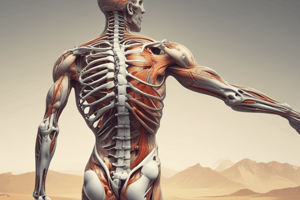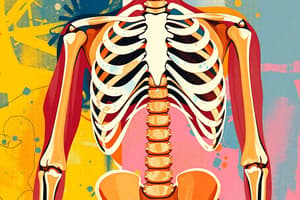Podcast
Questions and Answers
What is one of the primary functions of the musculoskeletal system?
What is one of the primary functions of the musculoskeletal system?
- Transportation of nutrients
- Storage of genetic information
- Protection of vital organs (correct)
- Production of hormones
Which type of tissue is NOT part of the musculoskeletal system?
Which type of tissue is NOT part of the musculoskeletal system?
- Cartilage
- Bone
- Epithelial tissue (correct)
- Skeletal muscle
What is a major component responsible for movement within the musculoskeletal system?
What is a major component responsible for movement within the musculoskeletal system?
- Tendons (correct)
- Adipose tissue
- Cartilage
- Ligaments
Which of the following factors is related to changes in the musculoskeletal system due to aging?
Which of the following factors is related to changes in the musculoskeletal system due to aging?
Which diagnostic test would most likely be used to assess bone health in the musculoskeletal system?
Which diagnostic test would most likely be used to assess bone health in the musculoskeletal system?
Which type of cartilage contains a moderate amount of collagen and is found in articular surfaces of bones?
Which type of cartilage contains a moderate amount of collagen and is found in articular surfaces of bones?
What is the primary function of tendons?
What is the primary function of tendons?
What distinguishes ligaments from tendons?
What distinguishes ligaments from tendons?
What is the role of bursae in the body?
What is the role of bursae in the body?
What is a key characteristic of fascia?
What is a key characteristic of fascia?
What is the primary purpose of arthrocentesis?
What is the primary purpose of arthrocentesis?
Which of the following may be a nursing responsibility after performing arthrocentesis?
Which of the following may be a nursing responsibility after performing arthrocentesis?
What should be done to the site following an arthrocentesis procedure?
What should be done to the site following an arthrocentesis procedure?
What is a contraindication for performing an electromyogram (EMG)?
What is a contraindication for performing an electromyogram (EMG)?
What should a patient be informed about regarding discomfort during an EMG procedure?
What should a patient be informed about regarding discomfort during an EMG procedure?
What is the primary function of muscles in the musculo-skeletal system?
What is the primary function of muscles in the musculo-skeletal system?
Which type of muscle contraction results in muscle shortening to produce movement?
Which type of muscle contraction results in muscle shortening to produce movement?
What role do bones play in the musculo-skeletal system?
What role do bones play in the musculo-skeletal system?
Which of the following best describes hypertrophy in muscle physiology?
Which of the following best describes hypertrophy in muscle physiology?
What components make up a muscle structure?
What components make up a muscle structure?
What characteristic of cartilage is significant to its function?
What characteristic of cartilage is significant to its function?
Which type of bones would be classified as having a complex shape?
Which type of bones would be classified as having a complex shape?
What process occurs in the marrow of bones?
What process occurs in the marrow of bones?
What type of joint allows the most movement between bones?
What type of joint allows the most movement between bones?
What is a common effect of aging on joints?
What is a common effect of aging on joints?
Which subjective data should be gathered in a musculoskeletal assessment?
Which subjective data should be gathered in a musculoskeletal assessment?
Which of the following is a type of objective data collected during a musculoskeletal assessment?
Which of the following is a type of objective data collected during a musculoskeletal assessment?
What type of joint typically does not allow movement?
What type of joint typically does not allow movement?
Which condition is associated with decreased bone density in older adults?
Which condition is associated with decreased bone density in older adults?
During a physical examination of the musculoskeletal system, which procedure is NOT typically performed?
During a physical examination of the musculoskeletal system, which procedure is NOT typically performed?
What does the term 'functional assessment' refer to in musculoskeletal evaluations?
What does the term 'functional assessment' refer to in musculoskeletal evaluations?
Study Notes
Musculoskeletal System Structure & Function
- Supports the body, allows movement, protects vital organs, produces blood cells, and serves as a reservoir for minerals
- Consists of skeletal muscle, 5 types of connective tissues (bone, cartilage, ligaments, tendons, fascia) and bursae, joints
- Muscles are responsible for movement, posture, and heat production.
- Muscle fibers form a fascicle, fascicles form a muscle
- Muscle contractions are either Isometric (increased tension, no movement) or Isotonic (muscle shortening, produces movement)
- Muscle growth is called hypertrophy, muscle wasting is called atrophy
- Bones provide a framework for the body, act as levers for muscles, and protect organs. They also have hematopoietic tissue within the marrow.
- Bone cells include osteoblasts, osteocytes, and osteoclasts
- Bone composition is organic (collagen, water) and inorganic (calcium, phosphate)
- Bone tissue is either compact (cortical) or spongy (cancellous or trabecular).
- Hematopoiesis is the process of blood cell formation; occurs in the bone marrow.
- Cartilage is a rigid connective tissue providing support and cushioning. Types include:
- Hyaline (articular surfaces of bones, nose, trachea, bronchi)
- Elastic (ear, epiglottis, larynx)
- Fibrocartilage (mostly collagen)
- Ligaments attach bone to bone and are more elastic than tendons, providing stability.
- Tendons attach muscle to bone, they are extensions of muscle, and are stronger than ligaments.
- Fascia is a layer of connective tissue, can be superficial or deep, allows muscles to glide and provides strengthens.
- Bursa is a sac of connective tissue that contains synovial fluid, located at bony prominences and joints to relieve pressure and prevent friction.
- Joints are where bones meet, they allow movement. Types of joints include:
- Nonsynovial (fibrous)
- Synovial (diarthrodial)
- Cartilaginous
Musculoskeletal System Aging
- Decreased muscle cells, elasticity in ligaments and cartilage.
- Increased joint problems, osteoporosis, and fractures.
Musculoskeletal Assessment
- Subjective data focuses on health history
- Objective data focuses on physical exam
- Health history questions should be specific to joints, muscles, bones, ADL's, self-care behaviors, weakness, injuries, and mobility.
- Past medical history, chronic conditions, medications, surgeries, and treatments relevant to the musculoskeletal system should be assessed
- Physical Exam includes inspection, palpating, range of motion, muscle strength testing, measurement, and other invasive tests for obtaining samples or injecting medication.
Diagnostic Tests
- Arthrocentesis is a procedure to obtain synovial fluid, remove pus or blood, or inject medications.
- Electromyography (EMG) uses needles to record electrical activity in muscle contractions. It is useful for detecting muscle weakness or motor neuron dysfunction.
Studying That Suits You
Use AI to generate personalized quizzes and flashcards to suit your learning preferences.
Related Documents
Description
Explore the components and functions of the musculoskeletal system in this quiz. Understand how muscles and bones support bodily movement, protect organs, and contribute to various physiological processes. Test your knowledge on muscle contractions, growth, and the types of connective tissues involved.




